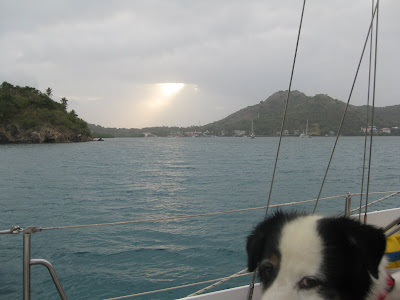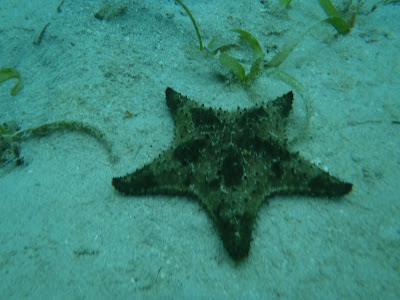
At daybreak we hauled anchor and made our way towards the mouth of the Rio Dulce. There is a notorious mud bank at the entrance of the river that is only 7 ft deep at high tide. We’d waited for high tide of course, but as our draft is 6 ½ feet, it was questionable whether we would make it without a tow.
I had envisioned that the mud bank was rather narrow, and that we would definitely know when we had passed it. In fact it was actually quite wide so our keel skidded along the bottom for at least half an hour before we finally got stuck. We pulled the jib out to see if we couldn’t lean over a bit to lessen our draft, but it wasn’t working. After fifteen minutes with no forward progress, a panga (they call them lanchas here) came out to ask if we needed a tow. Yes, yes we did. $30? Fine.
Just as we were about to throw them our halyard, we noticed El Tiburon had moved forward an inch. We waited, and sure enough she moved forward another inch. Soon we had broken free of the mud. Hooray!
Then we motored forward about twenty yards and anchored, where the water was still 7ft deep. We hoisted our yellow quarantine flag and waited for the authorities at Livingston to board our boat and check us into Guatemala.
We had an hour to kill while they completed the paperwork, so we took a panga to shore and had some breakfast. Livingston was a charming little Caribbean town with cobblestone streets and good food. The people were remarkably warm and friendly and every person we encountered was eager to be of assistance.


Around 10:00AM we began our inland voyage at a steady pace of six knots. The first part of the river snakes through an incredible narrow gorge with thick rainforest blanketing the steep walls on both sides. Birds and butterflies abound, and in the eddies children fish in dugout canoes. “Rio Dulce” means “Sweet River,” which may be due to the fact that it has a distinctively sweet smell, at times almost floral.



Four hours later we arrived in the town of Rio Dulce/Fronteras. After scouting out our marina options we chose Hacienda Tijax. Both a marina and “jungle lodge,” Tijax sits on the water across from town and features wooden plank walkways throughout the entire complex. It is a beautiful place run by lovely people. Neither the setting nor the staff can be beat.


El Tiburon needs her floors varnished and her teak decks replaced, both of which she will have done while waiting out the hurricane season in Rio Dulce.




























